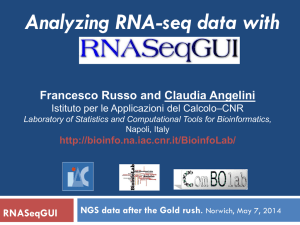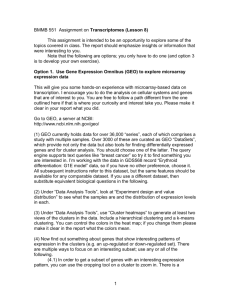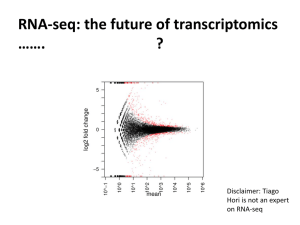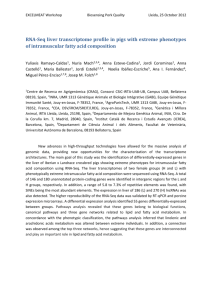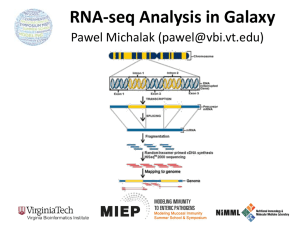tpj12498-sup-0006-Legends
advertisement
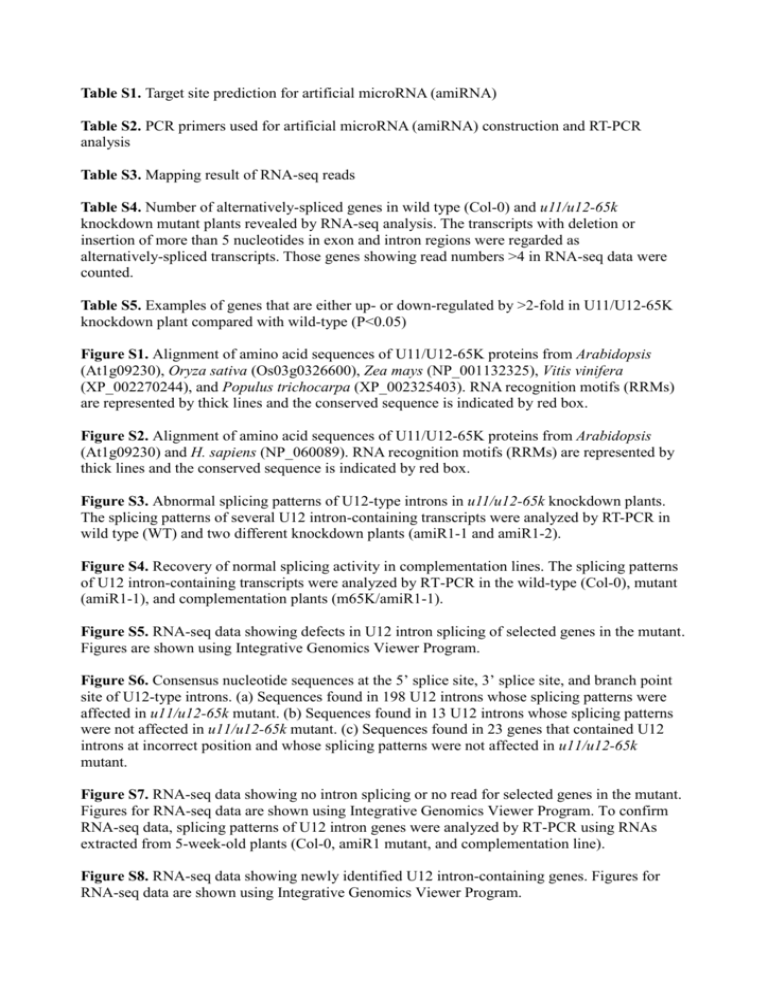
Table S1. Target site prediction for artificial microRNA (amiRNA) Table S2. PCR primers used for artificial microRNA (amiRNA) construction and RT-PCR analysis Table S3. Mapping result of RNA-seq reads Table S4. Number of alternatively-spliced genes in wild type (Col-0) and u11/u12-65k knockdown mutant plants revealed by RNA-seq analysis. The transcripts with deletion or insertion of more than 5 nucleotides in exon and intron regions were regarded as alternatively-spliced transcripts. Those genes showing read numbers >4 in RNA-seq data were counted. Table S5. Examples of genes that are either up- or down-regulated by >2-fold in U11/U12-65K knockdown plant compared with wild-type (P<0.05) Figure S1. Alignment of amino acid sequences of U11/U12-65K proteins from Arabidopsis (At1g09230), Oryza sativa (Os03g0326600), Zea mays (NP_001132325), Vitis vinifera (XP_002270244), and Populus trichocarpa (XP_002325403). RNA recognition motifs (RRMs) are represented by thick lines and the conserved sequence is indicated by red box. Figure S2. Alignment of amino acid sequences of U11/U12-65K proteins from Arabidopsis (At1g09230) and H. sapiens (NP_060089). RNA recognition motifs (RRMs) are represented by thick lines and the conserved sequence is indicated by red box. Figure S3. Abnormal splicing patterns of U12-type introns in u11/u12-65k knockdown plants. The splicing patterns of several U12 intron-containing transcripts were analyzed by RT-PCR in wild type (WT) and two different knockdown plants (amiR1-1 and amiR1-2). Figure S4. Recovery of normal splicing activity in complementation lines. The splicing patterns of U12 intron-containing transcripts were analyzed by RT-PCR in the wild-type (Col-0), mutant (amiR1-1), and complementation plants (m65K/amiR1-1). Figure S5. RNA-seq data showing defects in U12 intron splicing of selected genes in the mutant. Figures are shown using Integrative Genomics Viewer Program. Figure S6. Consensus nucleotide sequences at the 5’ splice site, 3’ splice site, and branch point site of U12-type introns. (a) Sequences found in 198 U12 introns whose splicing patterns were affected in u11/u12-65k mutant. (b) Sequences found in 13 U12 introns whose splicing patterns were not affected in u11/u12-65k mutant. (c) Sequences found in 23 genes that contained U12 introns at incorrect position and whose splicing patterns were not affected in u11/u12-65k mutant. Figure S7. RNA-seq data showing no intron splicing or no read for selected genes in the mutant. Figures for RNA-seq data are shown using Integrative Genomics Viewer Program. To confirm RNA-seq data, splicing patterns of U12 intron genes were analyzed by RT-PCR using RNAs extracted from 5-week-old plants (Col-0, amiR1 mutant, and complementation line). Figure S8. RNA-seq data showing newly identified U12 intron-containing genes. Figures for RNA-seq data are shown using Integrative Genomics Viewer Program. Figure S9. Alternative splicing patterns of selected U12 introns in u11/u12-65k knockdown mutant. RNA-seq data are shown using Integrative Genomics Viewer Program. To confirm RNA-seq data, alternative splicing patterns of U12 intron genes were analyzed by RT-PCR using RNAs extracted from 5-week-old plants (Col-0, amiR1 mutant, and complementation line). Asterisks indicate alternatively spliced bands. Figure S10. Purification of GST-65K fusion proteins. The GST fusion proteins were expressed in E. coli and the purified GST, GST-GRP7, and GST-65K fusion proteins were analyzed by SDS-PAGE. Data S1. RNA-seq data showing list of U12 intron genes. Data S2. RNA-seq data showing list of alternatively-spliced genes. Data S3. Microarray data showing list of genes either up- or down-regulated in u11/u12-65k knockdown mutant.
